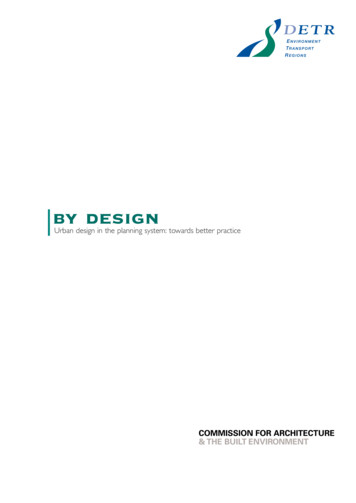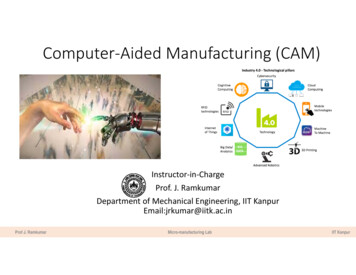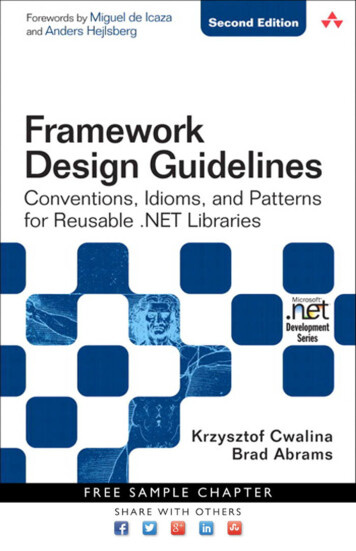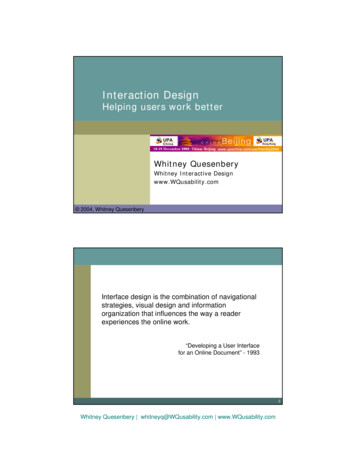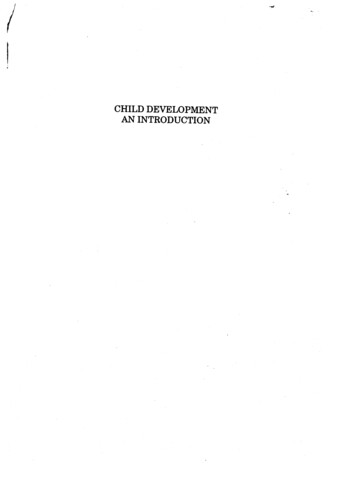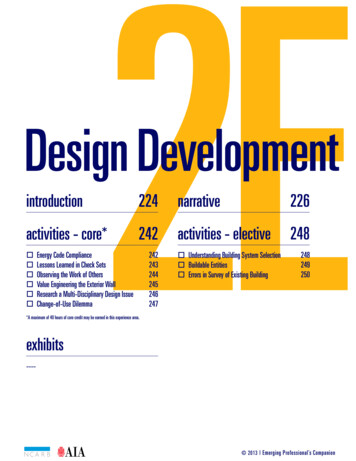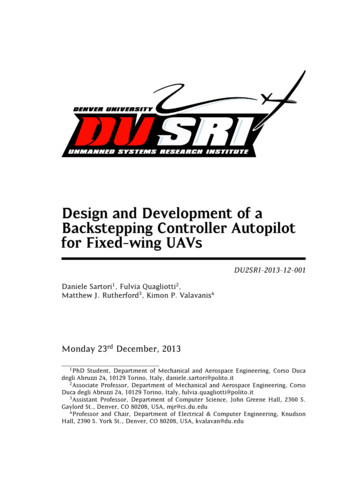
Transcription
Design and Development of aBackstepping Controller Autopilotfor Fixed-wing UAVsDU2SRI-2013-12-001Daniele Sartori1 , Fulvia Quagliotti2 ,Matthew J. Rutherford3 , Kimon P. Valavanis4Monday 23rdDecember, 2013PhD Student, Department of Mechanical and Aerospace Engineering, Corso Ducadegli Abruzzi 24, 10129 Torino, Italy, daniele.sartori@polito.it2 Associate Professor, Department of Mechanical and Aerospace Engineering, CorsoDuca degli Abruzzi 24, 10129 Torino, Italy, fulvia.quagliotti@polito.it3 Assistant Professor, Department of Computer Science, John Greene Hall, 2360 S.Gaylord St., Denver, CO 80208, USA, mjr@cs.du.edu4 Professor and Chair, Department of Electrical & Computer Engineering, KnudsonHall, 2390 S. York St., Denver, CO 80208, USA, kvalavan@du.edu1
AbstractBackstepping is one of the most promising advanced control laws developed for xed-wing Unmanned Aerial Vehicles (UAVs). Its nonlinearity combined with adaptation guarantees adequate performance over thewhole ight envelope even when the aircraft model is not exact. In theliterature, there are several attempts to apply a backstepping controller toaspects of xed-wing UAV ight. Few of them attempt a simultaneous longitudinal and latero-directional aircraft control, and the majority of thesehave not been implemented in a real-time controller. In this paper a backstepping approach able to control longitudinal and latero-directional motions is presented. Rapidly changing inner-loop variables are controlledwith non-adaptive backstepping, less dynamic outer-loop variables arecontrolled with PID gains. The controller is evaluated through softwarein-the-loop simulation in both continuous and discrete time domains, inthe rst case on two aircraft with di erent capabilities. The behavior withparametric uncertainties in the aircraft model or in presence of noise isalso tested. The results of a real-time implementation on a microcontroller are presented and its performance is evaluated through hardwarein-the-loop simulation. Overall, the proposed backstepping controllerhas good performance on the aircraft evaluated for complex maneuversinvolving control of multiple changing variables simultaneously.
ContentsNomenclatureii1Introduction12Related Work43Fixed-wing Aircraft Model64Control Design115Software-in-the-loop Simulations5.1 Continuous Time Simulations . . . . . . . . . . . . . . . .5.2 Discrete Time Simulations . . . . . . . . . . . . . . . . . .1818266Hardware-in-the-loop Simulations307Discussion, Conclusions and Future Work334.1 Backstepping Controller . . . . . . . . . . . . . . . . . . .4.2 Control Strategy . . . . . . . . . . . . . . . . . . . . . . .- i-1115
NomenclaturebCL , CYCLαClβ , Clβ̇ , Clp , ClrCm0 , Cmα , Cmα̇ , CmqCnβ , Cnβ̇ , Cnp , CnrClδa , Clδe , ClδrCmδa , Cmδe , CmδrCnδa , Cnδe , CnδrcE(Φ)TF (Fx , Fy , Fz )f (ω1 , y)fα (α, yα ), fβ (β, yβ )fi (x, ξj )gg2 , g3Hh, hrefIku , k1 , k2kα,1 , kα,2 , kβ,1 , kβ,2Lif tTM (M, L, N )mp̂, q̂ , r̂ps , prefsRsbTTuc (u1 , u2 , u3 )uswingspan, maerodynamic coe cientslift aerodynamic derivativeroll moment aerodynamic derivativespitch moment aerodynamic derivativesyaw moment aerodynamic derivativesroll moment control derivativespitch moment control derivativesyaw moment control derivativeswing mean aerodynamic chord, mrotation matrixbody-axes force vector, Nchange of variable functionfunctions of the aircraft statesgeneral nonlinear functiongravity acceleration, m/s2gravity contributions, m/s2change of variable reference valuemeasured and reference altitude, mbody-axes inertia matrix, kg·m2change of variable backstepping controller gainsbackstepping controller gainslift force, Nbody-axes moment vector, N·maircraft mass, kgnondimensional angular ratesmeasured and reference stability-axes roll rate, rad/srotation matrixengine thrust, Ncontrol action vector, rad/s2change of variable control action- ii-
VLV , V refTV (u, v, w)W (x1 )X, Y , ZXB , YB , ZBXN , YN , ZNXS , YS , ZSXW , YW , ZWx1 , x2xyα, αrefβδthδ (δa , δe , δr )TξjσΦ (φ, θ, ψ)TΨ(x1 )ψ , ψ refΩ(x1 )ω (p, q, r)Tωs (ps , qs , rs )Tω1 , ω2global control Lyapunov functionmeasured and reference linear velocity, m/sbody-axes linear velocity vector, m/stemporary control Lyapunov functionbody-axes aerodynamic forces, Nbody axesNED axesstability axeswind axesglobal change of variable statesgeneral state vector Rnchange of variable statemeasured and reference angle of attack, radsideslip angle, radthrottle commandsurface de ections vector, radgeneral scalar statesensor measure standard deviationbody axes to NED axes Euler angles vector, radfunction of the global change of variable statemeasured and reference heading angle, radglobal change of variable functionbody-axes angular velocity vector, rad/sstability-axes angular velocity vector, rad/schange of variable controlled states- iii-
Chapter 1IntroductionSmall xed-wing Unmanned Aerial Vehicle (UAV) ight dynamics are characterized by highly nonlinear behavior. A severe coupling exists betweenlongitudinal and latero-directional dynamics and the sensitivity to external disturbances is considerable. The interest in the problem of nding asuitable control law for these systems is growing in response to the recognition that these platforms will soon be performing missions in manycivilian applications. The wide range of possible missions, for instancetra c surveillance or re ghter support, is stimulating research and development of unmanned aerial systems of di erent size and con guration.A signi cant part of this research is dedicated to the design and development of adequate on-board controllers. Recent surveys by Chao, Caoand Chen [1] and Ollero and Merino [2] illustrate the current technologyavailable for autopilot systems and describe the control laws commonlyemployed. The use of PID gains is still a popular approach in practice,in particular when dealing with commercial o -the-shelf autopilots suchas the MicroPilot MP Series. This method guarantees simple implementation and low computational e ort. The designer has adequate controlover the system response and a clear understanding of the control action.The tuning of the PID gains can be performed with many non-heuristicmethods, as explained in [3] and [4]. One drawback of the standard PIDapproach is the inability to deal with the ight envelope that might berequired in most advanced mission pro les. As the performance of a PIDcontroller decreases far from the design point, gain scheduling is a common approach to extend the validity of this technique to the whole ightenvelope. Another disadvantage of PIDs is that they do not guaranteerobustness to model parametric uncertainties which are a common occurrence in small xed-wing UAVs.Researchers are currently developing nonlinear, adaptive and robust- 1-
CHAPTER 1. INTRODUCTIONcontrol laws able to theoretically guarantee satisfying performance overa large ight envelope also in case of uncertainties. For instance the authors of [5] propose a nonlinear model predictive control for xed-wingUAV path tracking, [6] investigates the feasibility of H2 and H autopilotsfor longitudinal UAV control and [7] presents a combined adaptive control law based on shunting method and passi cation for an UAV autopilothoming guidance system. Nevertheless, the constraints imposed by realtime implementation often make these algorithms very challenging forthe limited computational platforms available for small scale UAVs. As anexample, the controller proposed in [5] is successfully implemented in adedicated onboard computer installed on an experimental xed-wing UAVand tested with real-time hardware-in-the-loop simulation. The authors,however, underline the need for a compromise between smooth convergence and computational performance in the determination of the receding horizon size. High computational requirements, complex algorithmsand the necessity to smoothly combine high-level intelligent tasks withlow-level input/output routines are the main obstacles. The miniaturization and reduction in cost of microcontrollers, together with their increasein performance, see [8] and [9], is now enabling researchers to implementunmanned aircraft actually own by self-developed control laws. Whereasseveral examples have been published for rotorcraft (an excellent surveyis [10]) there are relatively few for xed-wing aircraft. The di usion offrameworks for control law development (e.g., [11] - [14]) has helped toreduce the barriers to successful implementation. Two examples are [15],where a neural network adaptive controller is used for the transition fromhorizontal ight to hover, and [16], where a nonlinear dynamic inversionapproach is used for formation ight.Within this context, an autopilot con guration for longitudinal andlatero-directional aircraft control based on nonlinear backstepping is presented in this paper: emphasis is given to the control law design and toits real-time hardware/software implementation. Di erently from manyrelated studies, the possibility to implement the proposed approach ona microcontroller board allows to actually exploit on a xed-wing UAVthe advantages of the backstepping controller. In fact, the backsteppingcontroller is chosen for its ability to deal with nonlinearities. Unlike fromtraditional linear control techniques, such as LQ or feedback linearization,a nonlinear control law applied to nonlinear aircraft dynamics guaranteessatisfying performance over the whole ight envelope [17]. With backstepping control design, useful nonlinearities are maintained and additional nonlinear damping terms can be introduced to increase robustnessto model errors or to improve transient performance [18]. Furthermore,- 2-
CHAPTER 1. INTRODUCTIONas backstepping belongs to the Lyapunov family of techniques it has guaranteed convergence of the tracking error and asymptotic stability [19].The proposed approach is demonstrated to be easily implementable on amicrocontroller board suitable for small UAV application.The paper is organized as follows: Section II describes applicationsof backstepping controllers to UAVs; Section III brie y presents the aircraft equations of motion and how they are arranged in a suitable formfor the backstepping controller. Section IV introduces the control designand strategy. Section V describes the results of software simulation evaluation, Section VI presents the hardware implementation and results ofhardware-in-the-loop (HIL) simulations. Finally, Section VII concludesand describes the future work towards achieving ight tests.- 3-
Chapter 2Related WorkA variety of projects illustrate the application of backstepping to xedwing aircraft ight control. Unlike with rotorcraft, the di culty for xedwing aircraft is in arranging the equations of motion into the requiredcascade form. In the literature there are several examples where longitudinal and latero-directional controls are independent. For instance, [20]presents an adaptive backstepping control law for angle of attack tracking, [21] uses adaptive backstepping for UAV velocity and ight path anglecontrol and [22] combines L1 adaptive methodology with backsteppingfor longitudinal control of a multi-axis thrust vectoring ghter aircraft.UAV trajectory tracking with adaptive backstepping is described in [23],where velocity and roll angle are controlled. The path-following problemis addressed in [24], where the roll angle command is generated throughbackstepping with the parameter adaptation technique, hardware-in-theloop (HIL) simulations validate the results.The number of works describing combined longitudinal and laterodirectional aircraft control is limited. In [25], outer loop variables, incidence, sideslip and roll angles, are controlled by adaptive backsteppingwith neural networks through body-axes angular rates. In [26], constrained adaptive backstepping with neural adaptation laws is employedfor tracking angle of attack, stability-axes roll rate and total velocity whilesideslip is maintained at zero.In contrast to the majority of existing work, an autopilot con guration for combined longitudinal and latero-directional xed-wing UAV control based on the backstepping technique is presented in this paper. Theinner-loop variables angle of attack, sideslip angle and stability-axes rollrate are controlled via the backstepping approach described in [27] andwith more details in [28]. This method is designed for general aircraft maneuvering within the whole ight envelope, its ability to deal with high an- 4-
CHAPTER 2. RELATED WORKgles of attack and sharp turns typical of small highly-maneuverable UAVswill be demonstrated. Nonlinear natural-stabilizing aerodynamic loadsare included and employed by the controller. This approach is di erentfrom feedback linearization, where these forces are rst modeled and thencanceled, the nonlinear backstepping approach allows for less accurateknowledge of the aircraft dynamics. Less dynamic outer-loop variables,velocity, altitude and heading, are, for the moment, controlled by PIDgains. This choice allows the designer to maintain a clear understandingof the control action, to limit required computational power and to easethe implementation procedure. The main purpose of this work, in fact, isto provide a starting framework for the actual employment of backstepping control technique on microcontrollers for small UAVs. Adaptationand a more advanced outer loop design is beyond the scope of this paper.A constant in all the backstepping approaches summarized above isthe combination of backstepping controller with complex adaptive laws.The bene ts of combining nonlinear control with advanced adaptation areclear, but the problems of real-time implementation might be considerable. To our knowledge, aside from [24], none of the adaptive backstepping implementations described above have been performed on microcontrollers suitable for small UAVs. The algorithm described in [29],based on adaptive backstepping for directional control in the presence ofcrosswind, is currently being implemented; this e ort is aided by the limited number of controlled variables and the simplicity of the adaptationapproach. What seems to be the only application of the backsteppingcontroller on a ying xed-wing unmanned aircraft is presented in [30].There, basic roll and pitch angles hold and trimming tasks are achievedthrough adaptive backstepping implemented on a Procerus Kestrel autopilot. In the present paper an innovative use of microprocessor technology based on cutting-edge transistor computers is employed to supportthe controller implementation [31]. The combination of this tool with theproposed control layout strongly facilitates the passage from theoreticalsimulation to practical application. In fact, HIL simulations validate thecontrol scheme, real-time operation is demonstrated with satisfying ightperformances.- 5-
Chapter 3Fixed-wing Aircraft ModelFixed-wing aircraft dynamics are de ned by a six-degree of freedom model.Three sets of di erential equations describe the forces and moments acting on the airplane and its orientation with respect to a reference system [32]. Generic body axes are introduced: XB and ZB lie in the aircraftplane of symmetry, with XB parallel to the fuselage reference line and ZBdirected from the upper to the lower surface of the wing airfoil; the YBaxis is selected so that the coordinate frame is right-handed. Body axeshave origin in the center of gravity and are xed on the aircraft (Fig. 3.1).The force equation is:mV̇ F ω mV(3.1)where m is the aircraft mass. V (u, v, w)T is the linear velocity vector andω (p, q, r)T is the angular velocity vector, all expressed in body axes. Theforce vector F (Fx , Fy , Fz )T represents the sum along XB , YB and ZB of allforces acting on the aircraft center of mass: aerodynamics forces, enginethrust and gravity force. The moment equation has a similar structure:I ω̇ M ω Iω(3.2)where I is the body-axes inertia matrix: Ixx0 IxzIyy0 I 0 Ixz 0IzzThe vector M (M, L, N )T contains the sum of the moments aboutXB , YB and ZB generated by aerodynamic forces and engine thrust. Theattitude equation is:Φ̇ E(Φ)ω(3.3)- 6-
CHAPTER 3. FIXED-WING AIRCRAFT MODELwhere: 1 sin φ tan θ cos φ tan θcos φ sin φ E(Φ) 00 sin φ/ cos θ cos φ/ cos θThe vector Φ (φ, θ, ψ)T contains the Euler angles between the body axesand the North-East-Down (NED) axes reference system. These angles arecalled, respectively, roll, pitch and yaw. NED axes are centered on theaircraft center of mass. The vertical axis ZN is directed along the localgravity acceleration vector, XN points towards North, YN points towardsEast. The XN and YN axes belong to a plane parallel to another planetangent to the Earth surface at zero altitude.The recursive nature of the backstepping controller requires that theequations governing the system may assume a general triangular structurecalled pure-feedback form [18]: ẋ f (x) g(x)ξ1 ξ 1 f1 (x, ξ1 , ξ2 ) ξ 2 f2 (x, ξ1 , ξ2 , ξ3 ). . ξ k 1 fk 1 (x, ξ1 , ., ξk ) ξk fk (x, ξ1 , ., ξk , ub ).(3.4)In Equation (3.4) x Rn is the state vector and ξ1,.,k are scalars denotingother states of the system. The functions fi (i 1, ., k) are nonlinear anddepend only on x and on the states ξj (j 1, ., i 1), i.e., they depend atmost on the state variable of the upper order subsystem. The scalar ub isthe external controller of the global system; each subsystem representedby the state ξl (l 1, ., k 1) is controlled by the virtual control input ξl 1 .Equations (3.1)-(3.2)-(3.3), as such, cannot assume the structure of(3.4). Since forces and moments in F and M are, in general, function ofthe states V and ω and of the aerodynamic angles and control actions,the cascade form is not respected. Nevertheless, under the assumptionsdescribed below it is possible to convert the equations of motion into asuitable form for a limited number of aircraft states: angle of attack α,sideslip angle β and stability-axes roll rate ps , see Fig. 3.1. The aim is todesign a controller so that α αref , ps prefand β 0. Control over anglesof attack and roll rate is essential to determine, respectively, the longitudinal behavior and the ight direction. A null sideslip angle is desired incruise ight to achieve symmetric ight and to reduce aerodynamic drag.- 7-
CHAPTER 3. FIXED-WING AIRCRAFT MODELThe ability of an aircraft to cancel sideslip angle perturbation is a sign ofits latero-directional static stability.Figure 3.1: Controlled variables and reference axes at t0Stability axes are a particular type of body axes where XS lies alongthe projection of V (at initial reference time t0 ) on the aircraft plane ofsymmetry, ZS is positive from the upper to the lower side of the wingairfoil, YS completes the right handed reference frame (Fig. 3.1). XS andXB are separated by the angle of attack, a single rotation of magnitude αabout YS YB is su cient to align body axes with stability axes. Suchrotation allows the de nition of angular velocities in stability axes ωs (ps , qs , rs )T as:ωs Rsb ω(3.5)where Rsb is the rotation matrix: cos α 0 sin α010 Rsb sin α 0 cos αThe dynamics considered for the control design are obtained from theforce equation written in wind axes, the complete derivation is availablein [28]. Wind axes are de ned as follows: XW is aligned with the airspeeddirection, YW is orthogonal to XW oriented from left to right with respectto the center of mass trajectory, ZW lies in the plane of symmetry of theaircraft, directed from the upper to the lower wing airfoil surface.Given this background, the following assumptions are made:- 8-
CHAPTER 3. FIXED-WING AIRCRAFT MODEL: The de ection of control surfaces only generates avariation in moments, the variation in forces is small enough to beneglected. Assumption 1 Assumption 2: Lift and side force coe cients, CL and CY , only depend on aerodynamic angles and not on aerodynamic angle rates ofchange: CL CL (α), CY CY (β).The rst assumption is reasonable for aircraft with traditional con guration, so that control surfaces are far from the aircraft center of gravity[32]. The de ection of a control surface generates forces and, as a consequence, moments. The comparison between the control derivative fora force and the one for the resulting moment shows that, in general, themoment derivative has same order of magnitude or is larger. In fact, itsde nition includes, among other terms, the product between the forcederivative and the distance of the control surface from the center of gravity. Furthermore, the addition of a reference lever-arm distance in themoment mathematical formulation, see for instance Equation (4.11), increases the moment contribution with respect to the force contribution.Once the trim condition is achieved, the control de ections for maneuver are minimal, reducing to a negligible value the variation of forces soproduced.Assumption 2 is considered valid in steady ight or during smooth maneuvers. In fact, the disregarded aerodynamic derivatives CLα̇ and CY β̇ areoriginated by the delay in the pressure distribution of the unsteady owto adjust to sudden attitude variation. Assumption 2 is on the conservative side as it targets progressive maneuvers, the ability of backsteppingto control aggressive ight will be demonstrated.The di erential equations governing the variation in time of the controlled variables α, β and ps are now obtained. The de nition of the aerodynamic angles is:wuvβ arcsinVα arctanwith:V V u2 v 2 w2The equations relating the derivatives of the aerodynamic angles with the- 9-
CHAPTER 3. FIXED-WING AIRCRAFT MODELangular velocities and α and β themselves are:Z cos α (X T ) sin α mg2mV cos βY T cos α sin β mg3β̇ p sin α r cos α mVα̇ q (p cos α r sin α) tan β (3.6)where T is the engine thrust and X , Y , Z are the aerodynamic forces inbody axes. The gravity acceleration components g2 and g3 are:g2 g(cos α cos θ cos φ sin α sin θ)g3 g(cos β cos θ sin φ sin β cos α sin θ sin α sin β cos θ cos φ)(3.7)where g 9.81 m/s2 is the gravity acceleration. Equation (3.6) can bewritten in a more compact and meaningful form. The relationship:Lif t X sin α Z cos αis used to include the lift force Lif t in the α̇ equation. Thanks to Equation(3.5) stability-axes angular rates are introduced in α̇ and β̇ dynamics, theresult is: Lif t T sin α mg2mV cos βY T cos α sin β mg3β̇ rs mVα̇ qs ps tan β (3.8)The backstepping controller is designed to directly control the stabilityaxes angular velocities ωs through the control vector uc (u1 , u2 , u3 )T .Therefore, the dynamics of the stability-axes angular velocities are described by the relationship ω̇s uc . Combining this formulation withEquation (3.8) gives: ṗs u1 Lif t T sin α mg2 α̇ qs ps tan β mV cos βq̇s u2 Y T cos α sin β mg3 β̇ rs mV ṙs u3(3.9)Note that the lift force Lif t depends on the angle of attack through theCL CL (α) coe cient and the side force Y on the sideslip angle throughthe CY CY (β) coe cient. The thrust T is considered independent fromthe aerodynamic angles.- 10-
Chapter 4Control Design4.1Backstepping ControllerIn order to simplify the controller design, an additional set of assumptionsis proposed: Assumption 3: The time derivatives of speed V , altitude h and heading ψ can be neglected as they have a slower rate of change comparedto the controlled variables α, β , and ps .: Actuators have rapid enough dynamics, thus, they canbe ignored in the design process.Assumptions 3 is mainly valid for cruise ight and progressive maneuvers.Here a controlled variation in the aircraft equilibrium state has a primarye ect on the faster dynamics characterizing the attitude, and a secondarye ect on the slow-changing variables de ning the navigation. Finally,Assumption 4 is very common and generally reasonable, provided thatAssumptions 2 and 3 are respected.Equation (3.9) is not suitable for the application of a total backstepping controller because the cascade form is not respected, in particulardue to the presence of β in the α dynamics, and vice versa. However byseparating its dynamics as:ṗs u1(4.1) Assumption 4 α̇ q p tan β Lif t T sin α mg2ssmV cos β q̇s u2(β̇ rs Y T cos α sin β mg3mVṙs u3- 11-(4.2)(4.3)
CHAPTER 4. CONTROL DESIGNthree sub-controllers stabilizing the desired states α, β and ps can be dened. These control laws are designed for a simultaneous action on thesethree variables, also taking into account cross-coupling e ects. In fact,it is possible to observe the presence of ps and β in the α dynamics and,at the same time, the presence of α in the β dynamics. Because of thiscoupling, the computation of a control action needs to consider, at eachmoment, the value of the state controlled by another control action. Forinstance, the control law de ning u2 is evaluated with the instantaneousvalue of ps , controlled by u1 , and β controlled by u3 . This occurrence isbene cial when dealing with maneuvers where strong coupling betweenlongitudinal and latero-directional planes exists.A simple proportional controller is chosen for ps , Equation (4.1), whilethe cascade form of Equation (4.2) and Equation (4.3) allows the application of backstepping controller for α and β .Note that Equations (4.2) and (4.3) have similar structure:(ω̇1 f (ω1 , y) ω2ω̇2 us(4.4)A single backstepping controller designed for Equation (4.4) is suitablefor Equations (4.2) and (4.3). As it is preferable to have the origin as thedesired equilibrium point, a change of variables is de ned:x1 ω1 Hx2 ω2 f (H, y)Ω(x1 ) f (x1 H, y) f (H, y)where H is the reference value for the controlled variable. The resultingdynamics are:(ẋ1 Ω(x1 ) x2ẋ2 us(4.5)The external control input us controls x2 that, in cascade, acts as virtualcontrol to stabilize x1 . Table 4.1 summarizes the relationships betweenthe variables used in the new and in the original systems. The functionsfα (α, yα ) and fβ (β, yβ ) are: Lif t T sin α mg2mV cos βY T cos α sin β mg3fβ (β, yβ ) mVfα (α, yα ) ps tan β - 12-
CHAPTER 4. CONTROL DESIGNTable 4.1: Change of variable relationshipsGeneral systemω1ω2usyf (ω1 , y)Hx1x2Ω(x1 )LongitudinalLatero-directionalαβqs rsu2 u3ps , β, V, h, θ, φα, V, h, θ, φfα (α, yα )fβ (β, yβ )refα0α αrefβqs fα (αref , yα ) rs fβ (0, yβ )reffα (α, yα ) fα (α , yα ) fβ (β, yβ ) fβ (0, yβ )As fully demonstrated in [28] through Lyapunov stability theory, asimple globally stabilizing control law for the system of Equation (4.5) is:(4.6)us ku (x2 Ψ(x1 ))if, for all x1 6 0, a constant ku exists such that:ku Ω(x1 )x1desis the deThe function Ψ(x1 ) is built so that Ψ(x1 ) xdes2 , where x2sired value for the state x2 acting as virtual control input for the subsystemx1 . This choice guarantees asymptotic stability for the subsystem x1 :Ẇ (x1 ) x2 xdes (Ω(x1 ) Ψ(x1 )) x1 0,2x1 6 0having chosen as temporary control Lyapunov function:1W (x1 ) x212Furthermore it can be demonstrated thatΨ(x1 ), is bounded:Ψ0 (x1 ),the time derivative of0 Ψ0 (x1 ) kuThe global control Lyapunov function used to de ne the control law ofEquation (4.6) is:ZVL x1 Ψ0 (y) (Ω(y) Ψ(y)) dy 0- 13-1(x2 Ψ(x1 ))22
CHAPTER 4. CONTROL DESIGNwhich satis es:V L Ψ0 (x1 ) (Ω(x1 ) Ψ(x1 ))2 (ku Ψ0 (x1 )) xe22where xe2 x2 xdes2 .A linear control is chosen assigning Ψ(x1 ) k1 x1 so that:us k2 (x2 k1 x1 )with k2 k1 max{0, ku }. Forminimizes the cost function:Z0 k2 2k1the controller is optimal as it k2u2s22k1 (Ω(x1) k1 x1 ) k1 (x2 k1 x1 ) dt22k2Using the relationships of Table 4.1, the control laws for the systems ofEquations (4.2) and (4.3) are obtained: u2 kα,2 qs kα,1 α αref fα (αref , yα )u3 kβ,2 ( rs kβ,1 β fβ (0, yβ ))(4.7)with:kα,2 2kα,1 ,kβ,2 2kβ,1 ,kα,1 max{0, kα }kβ,1 max{0, kβ }(4.8)where: fα (α, yα )α,yα αfβ (β, yβ ) fβ (0, yβ )kβ maxβ,yββkα maxFinally, a proportional control is adopted for ps : u1 kps pref ps ,skps 0(4.9)The relation between control inputs and stability-axes angular accelerations is de ned by uc (u1 , u2 , u3 )T ω̇s . Angular accelerations are theresult of the variation in moments originated primarily by the de ectionof aircraft control surfaces. The vector of de ections δ is obtained fromthe moment equation: TTM(δ) I Rsbuc Ṙsbωs ω Iω(4.10)To calculate δ , a control strategy matching the controlled variables withthe aircraft control surfaces must be de ned.- 14-
CHAPTER 4. CONTROL DESIGN4.2Control StrategyThe controller described above stabilizes three variables connected withthe attitude of the aircraft. A global autopilot con guration capable ofcontrolling speed V , altitude h and heading ψ is required. In real-lifeimplementation, these variables could be easily measured with, respectively, a pitot tube, a barometric pressure sensor and magnetometer. Thecontrol strategy is de ned as follows: the backstepping controller acts onα, β and p in the inner-loop, three PID controllers act on V , h and ψ inthe outer-loop. This approach separates the fast dynamics, characterizingaircraft attitude, from the slower dynamics, characterizing aircraft navigation. The prompt response of the backstepping controller is necessarywhen dealing with fast-changing inner-loop variables. These, in fact, areof prime importance for the aircraft safety. For instance, an immediatecontrol of α for a UAV a ected by vertical gust could prevent the stall anddangerous ight regimes. Consistent with Assumption 3, slower variationof the navigation variables can be successfully handled using traditionalPID technique. PID gains are tuned manually following a trial and error approach. The goal is optimizing the response in terms of values ofovershoot,
Design and Development of a Backstepping Controller Autopilot for Fixed-wing UAVs DU2SRI-2013-12-001 Daniele Sartori 1, Fulvia Quagliotti 2, Matthew J. Rutherford 3, Kimon P. Valavanis 4 Monday 23 rd December, 2013 1 PhD Student, Department of Mechanical and Aerospace Engineering, Corso Duca degli Abruzzi 24, 10129 Torino, Italy, daniele.sartori@polito.it

